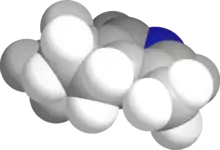Actinidine
Actinidine is an iridoid produced in nature by a wide variety of plants and animals. It was the first cyclopentanoid monoterpene alkaloid to be discovered.[2] It is one of several compounds that may be extracted from the valerian (Valeriana officinalis) root[3] and silver vine (Actinidia polygama), as well as several types of insects in the larval and imaginal stages.[4] Actinidine is a cat attractant, with effects like those of nepetalactone, the active compound found in catnip.
 | |
 | |
| Names | |
|---|---|
| IUPAC name
(S)-4,7-Dimethyl-6,7-dihydro-5H-cyclopenta[c]pyridine | |
| Identifiers | |
3D model (JSmol) |
|
| 81308 | |
| ChEBI | |
| ChemSpider | |
| KEGG | |
PubChem CID |
|
CompTox Dashboard (EPA) |
|
| |
| |
| Properties | |
| C10H13N | |
| Molar mass | 147.221 g·mol−1 |
| Melting point | < 25 °C (77 °F; 298 K) |
| Boiling point | 100 to 103 °C (212 to 217 °F; 373 to 376 K) at 9 mmHg[1] |
Except where otherwise noted, data are given for materials in their standard state (at 25 °C [77 °F], 100 kPa). | |
| Infobox references | |
Certain species of stick insects, including Megacrania batesii and Megacrania tsudai, possess a chemical defense mechanism which involves the secretion of an actinidine-containing substance from the prothoracic glands, when threatened by a predator.[5]
References
- Sakan, Takeo; Bulletin of the Chemical Society of Japan, 1959, V32, P315-16.
- Tsutsui, Minoru; Tsutsui, Ethel Ashworth (1959). "Diterpenoids". Chemical Reviews. 59 (6): 1031–75. doi:10.1021/cr50030a003.
- Janot MM, Guilhem J, Contz O, Venera G, Cionga E (1979). "Contribution to the study of valerian alcaloids (Valeriana officinalis, L.): actinidine and naphthyridylmethylketone, a new alkaloid (article in French)". Ann. Pharm. Fr. 37 (9–10): 413–20. PMID 547813.
- Weibel DB, Oldham NJ, Feld B, Glombitza G, Dettner K, Boland W (2001). "Iridoid biosynthesis in staphylinid rove beetles (Coleoptera: Staphylinidae, Philonthinae)". Insect Biochemistry and Molecular Biology. 31 (6–7): 583–591. doi:10.1016/s0965-1748(00)00163-6. PMID 11267897.
- Wu, I‐Hsin; Liu, Hsui‐Huei; Chen, Yu‐Yen; Tsai, Cheng‐Lung; Yu, Yi‐Ching; Hsiao, Chung‐Yi; Yeh, Wen‐Bin (2020). "Life cycles, phenology and genetic structure of endangered Megacrania tsudai Shiraki (Phasmatodea: Phasmatidae): Male individuals from a geographic parthenogenesis species". Entomological Science. 23 (2): 183–192. doi:10.1111/ens.12410. S2CID 216322536.
- Chapter 14 - Alkaloids Derived from Terpenoids, Editors: Shinji Funayama, Geoffrey A. Cordell, Alkaloids, Academic Press, 2015, pp. 233-55
This article is issued from Wikipedia. The text is licensed under Creative Commons - Attribution - Sharealike. Additional terms may apply for the media files.

